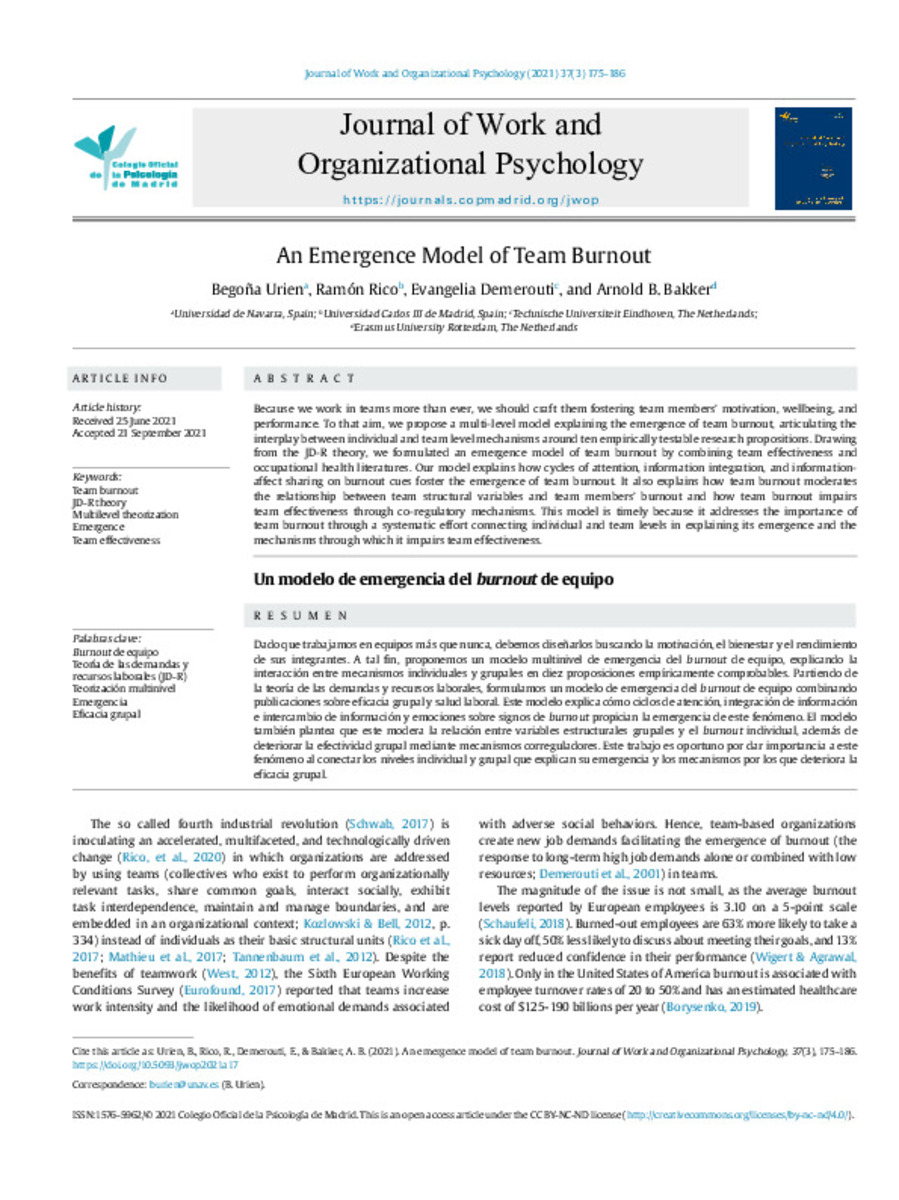Full metadata record
| DC Field | Value | Language |
|---|---|---|
| dc.creator | Urien-Angulo, B. (Begoña) | - |
| dc.creator | Rico, R. (Ramón) | - |
| dc.creator | Demerouti, E. (Evangelia) | - |
| dc.creator | Bakker, A.B. (Arnold B.) | - |
| dc.date.accessioned | 2024-01-11T13:31:47Z | - |
| dc.date.available | 2024-01-11T13:31:47Z | - |
| dc.date.issued | 2021 | - |
| dc.identifier.citation | Urien, B., Rico, R., Demerouti, E., and Bakker, A. B. (2021). An Emergence Model of Team Burnout. Journal of Work and Organizational Psychology, 37(3), 175 - 186. https://doi.org/10.5093/jwop2021a17 | es_ES |
| dc.identifier.issn | 1576-5962 | - |
| dc.identifier.uri | https://hdl.handle.net/10171/68303 | - |
| dc.description.abstract | Because we work in teams more than ever, we should craft them fostering team members’ motivation, wellbeing, and performance. To that aim, we propose a multi-level model explaining the emergence of team burnout, articulating the interplay between individual and team level mechanisms around ten empirically testable research propositions. Drawing from the JD-R theory, we formulated an emergence model of team burnout by combining team effectiveness and occupational health literatures. Our model explains how cycles of attention, information integration, and information-affect sharing on burnout cues foster the emergence of team burnout. It also explains how team burnout moderates the relationship between team structural variables and team members’ burnout and how team burnout impairs team effectiveness through co-regulatory mechanisms. This model is timely because it addresses the importance of team burnout through a systematic effort connecting individual and team levels in explaining its emergence and the mechanisms through which it impairs team effectiveness. | es_ES |
| dc.description.abstract | Dado que trabajamos en equipos más que nunca, debemos diseñarlos buscando la motivación, el bienestar y el rendimiento de sus integrantes. A tal fin, proponemos un modelo multinivel de emergencia del burnout de equipo, explicando la interacción entre mecanismos individuales y grupales en diez proposiciones empíricamente comprobables. Partiendo de la teoría de las demandas y recursos laborales, formulamos un modelo de emergencia del burnout de equipo combinando publicaciones sobre eficacia grupal y salud laboral. Este modelo explica cómo ciclos de atención, integración de información e intercambio de información y emociones sobre signos de burnout propician la emergencia de este fenómeno. El modelo también plantea que este modera la relación entre variables estructurales grupales y el burnout individual, además de deteriorar la efectividad grupal mediante mecanismos correguladores. Este trabajo es oportuno por dar importancia a este fenómeno al conectar los niveles individual y grupal que explican su emergencia y los mecanismos por los que deteriora la eficacia grupal. | es_ES |
| dc.language.iso | eng | es_ES |
| dc.rights | info:eu-repo/semantics/openAccess | es_ES |
| dc.subject | Team burnout | es_ES |
| dc.subject | JD-R theory | es_ES |
| dc.subject | Multilevel theorization | es_ES |
| dc.subject | Emergence | es_ES |
| dc.subject | Team effectiveness | es_ES |
| dc.subject | Burnout de equipo | es_ES |
| dc.subject | Teoría de las demandas y recursos laborales (JD-R) | es_ES |
| dc.subject | Teorización multinivel | es_ES |
| dc.subject | Emergencia | es_ES |
| dc.subject | Eficacia grupal | es_ES |
| dc.title | An Emergence Model of Team Burnout | es_ES |
| dc.title.alternative | Un modelo de emergencia del burnout de equipo | es_ES |
| dc.type | info:eu-repo/semantics/article | es_ES |
| dc.description.note | Creative Commons Attribution-NonCommercial-NoDerivatives 4.0 International License | es_ES |
| dc.identifier.doi | 10.5093/jwop2021a17 | - |
Files in This Item:
Statistics and impact
Items in Dadun are protected by copyright, with all rights reserved, unless otherwise indicated.






